Intel Architecture Day 2021: Alder Lake, Golden Cove, and Gracemont Detailed
by Dr. Ian Cutress & Andrei Frumusanu on August 19, 2021 9:00 AM ESTGracemont Microarchitecture (E-Core) Examined
The smaller core as part of Intel’s hybrid Alder Lake design is called an E-core, and is built on the Gracemont microarchitecture. It forms part of Intel’s Atom family of processors, and is a significant microarchitectural jump over the previous Atom core design called Tremont.
- 2008: Bonnell
- 2011: Saltwell
- 2013: Silvermont
- 2015: Airmont
- 2016: Goldmont
- 2017: Goldmont Plus
- 2020: Tremont
- 2021: Gracemont
Based on Intel’s diagrams, the company is pitching that the size of its Golden Cove core means that in the space it would normally fit one of its P-core designs, it can enable a four core cluster of E-cores along with a shared 4MB L2 cache between them.
For performance, Intel has some pretty wild claims. It splits them up into single thread and multi-thread comparisons using SPECrate2017_int.
When comparing 1C1T of Gracemont against 1C1T of Skylake, Intel’s numbers suggest:
- +40% performance at iso-power (using a middling frequency)
- 40% less power* at iso-performance (peak Skylake performance)
*'<40%' is now stood to mean 'below 40 power'
When comparing 4C4T of Gracemont against 2C4T of Skylake, Intel’s numbers suggest:
- +80% performance peak vs peak
- 80% less power at iso performance)peak Skylake performance
We pushed the two Intel slides together to show how they presented this data.
By these graphics it looks like that for peak single thread, we should see around +8% better than Skylake performance while consuming just over half the power – look for Cinebench R20 scores for one Gracemont thread around 478 then (Skylake 6700K scored 443). With +8% for single thread in mind, the +80% in MT comparing 4 cores of Gracemont to two fully loaded Skylake cores seems a little low – we’ve got double the physical cores with Gracemont compared to Skylake here. But there’s likely some additional performance regression with the cache structure on the new Atom core, which we’ll get to later on this page.
These claims are substantial. Intel hasn’t compared the new Atom core generation on generation, because it felt that having AVX2 support would put the new Atom at a significant advantage. But what Intel is saying with these graphs is that we should expect better-than Skylake performance at much less power. We saw Skylake processors up to 28 cores in HEDT – it makes me wonder if Intel might not enable its new Atom core for that market. If that’s the case, where is our 64-core Atom version for HEDT? I’ll take one.
Front End
The big item about the Tremont front end of the core was the move to dual three-wide decode paths, enabling two concurrent streams of decode that could support 3 per cycle. That still remains in Gracemont, but is backed by a double-size 64 KB L1 Instruction cache. This ties into the branch predictor which enables prefetchers at all cache levels, along with a 5000-entry branch target cache which Intel says in improved over the previous generation.
Back on the decoder, Intel supports on-demand decode which stores a history of previous decodes in the instruction cache and if recent misses are recalled at the decode stage, the on-demand stream will pull directly from the instruction cache instead, saving time – if the prefetch/decode works, the content in the instruction cache is updated, however if it is doing poorly then the scope is ‘re-enabled for general fetches’ to get a better understanding of the instruction flow. This almost sounds like a micro-op cache without having a physical cache, but is more to do about instruction streaming. Either way, the decoders can push up to six uops into the second half of the front end.
For Gracemont, the reorder buffer size has increased from 208 in Tremont to 256, which is important aspect given that Gracemont now has a total of 17 (!) execution ports, compared to eight in Tremont. This is also significantly wider than the execution capabilities of Golden Cove's 12 ports, related to the disaggregated integer and FP/vector pipeline design. However, despite that width, the allocation stage feeding into the reservation stations can only process five instructions per cycle. On the return path, each core can retire eight instructions per cycle.
Back End
So it’s a bit insane to have 17 execution ports here. There are a lot of repeated units as well, which means that Gracemont is expecting to see repeated instruction use and requires the parallelism to do more per cycle and then perhaps sit idle waiting for the next instructions to come down the pipe. Overall we have
- 4 Integer ALUs (ALU/Shift), two of which can do MUL/DIV
- 4 Address Generator Units, 2 Load + 2 Store
- 2 Branch Ports
- 2 Extra Integer Store ports
- 2 Floating Point/Vector store ports
- 3 Floating Point/Vector ALUs: 3x ALUs, 2x AES/FMUL/FADD, 1x SHA/IMUL/FDIV
It will be interesting to see exactly how many of these can be accessed simultaneously. In previous core designs a lot of this functionality would be enabled though the same port – even Alder Lake’s P-core only has 12 execution ports, with some ports doing double duty on Vector and Integer workloads. In the P-core there is a single scheduler for both types of workloads, whereas in the E-core there are two separate schedulers, which is more akin to what we see on non-x86 core designs. It’s a tradeoff in complexity and ease-of-use.
The back-end is support by a 32 KiB L1-Data cache, which supports a 3-cycle pointer chasing latency and 64 outstanding cache misses. There are two load and two store ports, which means 2x16 byte loads and 2 x 16 byte stores to the L1-D.
There is also has a shared 4 MB L2 cache across all four E-cores in a cluster with 17-cycle latency. The shared L2 cache can support 64 bytes per cycle read/write per core, which Intel states is sufficient for all four cores. The new L2 supports up to 64 outstanding misses to the deeper memory subsystem – which seems fair, but has to be shared amongst the 4 cores.
Intel states that it has a Resource Director that will arbitrate cache accesses between the four cores in a cluster to ensure fairness, confirming that Intel are building these E-cores in for multi-threaded performance rather than latency sensitive scenarios where one thread might have priority.
Other Highlights
As the first Atom core to have AVX2 enabled, there are two vector ports that support FMUL and FADD (port 20 and port 21), which means that we should expect peak performance compared to previous Atoms to be substantial. The addition of VNNI-INT8 over the AVX unit means that Intel wants these E-cores to enable situations where high inference throughput is needed, such as perhaps video analysis.
Intel was keen to point out that Gracemont has all of its latest security features including Control Flow Enhancement Technology (CET), and virtualization redirects under its VT-rp feature.
Overall, Intel stated that the E-cores are tuned for voltage more than anything else (such as performance, area). This means that the E-cores are set to use a lot less power, which may help in mobile scenarios. But as mentioned before on the first page, it will depend on how much power the ring has to consume in that environment - it should be worth noting that each four core Atom cluster only has a single stop on the full ring in Alder Lake, which Intel says should not cause congestion but it is a possibility – if each core is fully loaded, there is only 512 KB of L2 cache per core before making the jump to main memory, which indicates that in a fully loaded scenario, that might be a bottleneck.


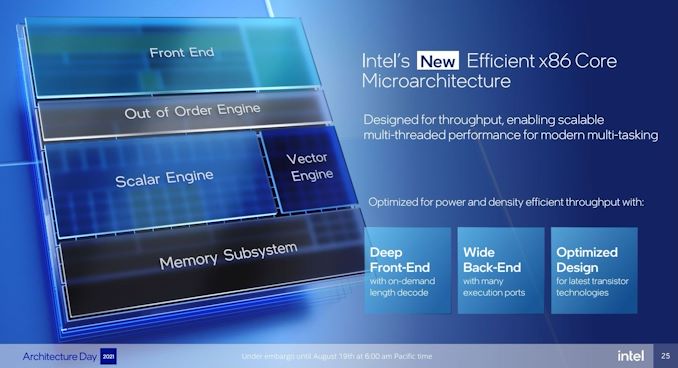
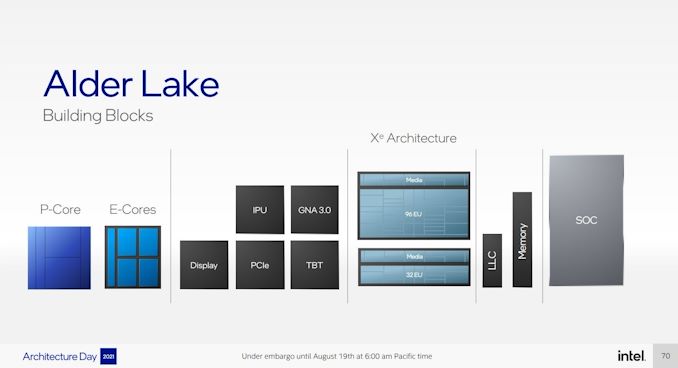

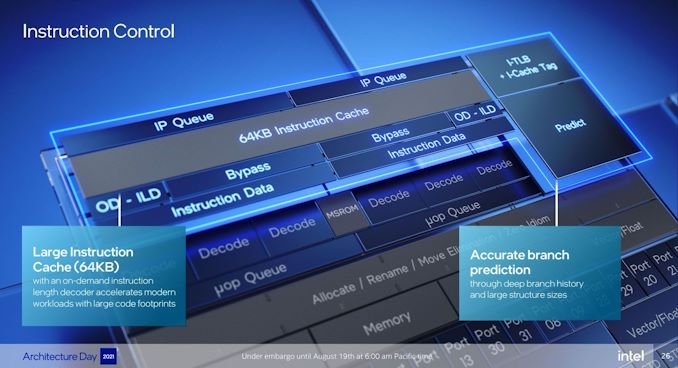
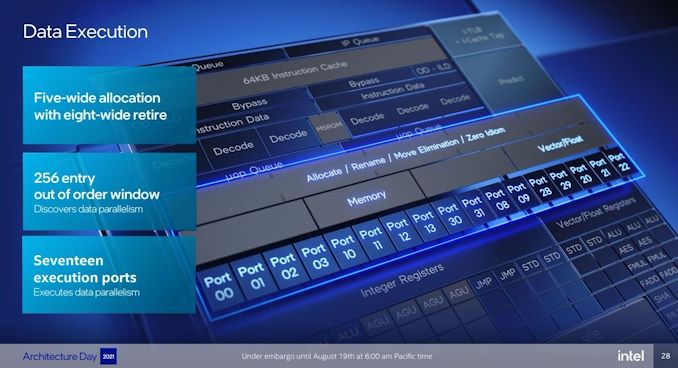
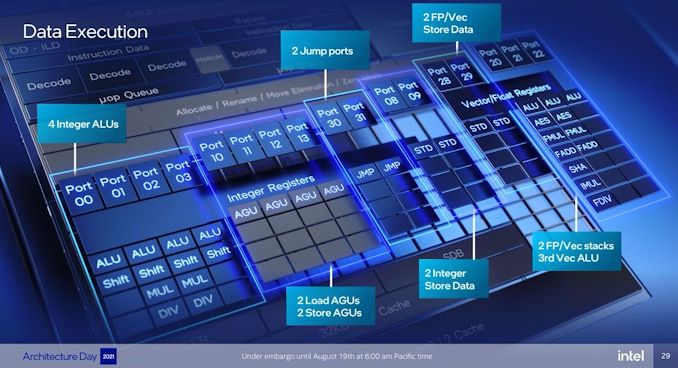









223 Comments
View All Comments
mode_13h - Thursday, August 19, 2021 - link
> On the E-core side, Gracemont will be Intel’s first Atom processor to support AVX2.Finally. It's about f'ing time, Intel.
> desktop processors and mobile processors will now have AVX-512 disabled in all scenarios.
> ...
> If AMD’s Zen 4 processors plan to support some form of AVX-512 ... we might be in
> some dystopian processor environment where AMD is the only consumer processor
> on the market to support AVX-512.
LOL! Exactly! I wouldn't call it "dystopian", exactly. Just paradoxical.
And now that Intel has been pushing AVX-512 adoption for the past 5 years, there should actually be a fair amount of software & libraries that can take advantage of it, making this the worst possible time for Intel to step back from AVX-512! Oh, the irony would be only too delicious!
> Intel is also integrating support for VNNI instructions for neural network calculations.
> In the past VNNI (and VNNI2) were built for AVX-512, however this time around Intel
> has done a version of AVX2-VNNI for both the P-core and E-core designs in Alder Lake.
Wow. That really says a lot about what a discombobulated mess the development of Alder Lake must've been! They thought the E-cores would be a good area-efficient way to add performance, but then AVX-512 probably would've spoiled that. So, then they had to disable AVX-512 in the P-cores. But, since that would hurt deep learning performance too much, they had to back-port VNNI to AVX2!
And then, we're left to wonder how much software is going to bother supporting it, just for this evolutionary cul-de-sac of a CPU (presumably, Raptor Lake or Meteor Lake will finally enable AVX-512 in the E-cores).
Gondalf - Thursday, August 19, 2021 - link
Have you realized this SKU was thinked for 7nm ??....and than backported to 10nm ???.Rocket Lake number two.
TomWomack - Thursday, August 19, 2021 - link
VNNI is four very straightforward instructions (8-bit and 16-bit packed dot-product with/without saturation), so the back port is unlikely to have been difficultmode_13h - Thursday, August 19, 2021 - link
Yeah, but it implies some chaos in the design process.Also, my question about how well-supported it will be stands. I think a lot of people aren't going to go back and optimize their AVX2 path to use it. Any focus on new instructions is likely to focus on AVX-512.
Spunjji - Monday, August 23, 2021 - link
If they kill AVX-512 in consumer with ADL only to bring it back in the next generation, I shall be laughing a hearty laugh. Another round of "developer relations" funding will be needed...Personally I think they never should have brought it to consumer.
mode_13h - Tuesday, August 24, 2021 - link
> I think they never should have brought it to consumer.I have my gripes against AVX-512 (mostly, with regard to the 14 nm implementation), but it's not all bad. I've read estimates that it only adds 11% to the core size of Skylake-SP (excluding the L3 cache slice & such). It was estimated at about 5% of a Skylake-SP compute tile. So, that means less than 5% of the total die size. So, it's probably not coming at too high a price.
Spunjji - Friday, August 27, 2021 - link
That's fair - my reasons for thinking they shouldn't have done it are more related to marketing and engineering effort than die space, though.They put in a lot of time and money to bring a feature to a market that didn't really need it, including doing a load of "developer relations" stuff to develop some cringe-worthy edge-case benchmark results, alongside a bunch of slightly embarrassing hype (including the usual sponsored posters on comment sections), all to lead up to this quiet little climb-down.
Seems like to me like it would have made more sense to designate it as an Enterprise Grade feature - an excuse to up-sell from the consumer-grade "Xeon" processors - and then trickle it down to consumer products later.
mode_13h - Saturday, August 28, 2021 - link
> Seems like to me like it would have made more sense to designate it as an Enterprise> Grade feature ... and then trickle it down to consumer products later.
Yeah, that's basically what they did. They introduced it in Skylake-SP (if we're not counting Xeon Phi - KNL), and kept it out of consumers' hands until Ice Lake (laptop) and Rocket Lake (desktop). It seems pretty clear they didn't anticipate having to pull it back, in Alder Lake, when the latter two were planned.
mode_13h - Saturday, August 28, 2021 - link
BTW, you know the Skylake & Cascade Lake HEDT CPUs had it, right? So, the whole up-sell scheme is what they *actually* did!TristanSDX - Thursday, August 19, 2021 - link
If ADL have disbaled features like part of L2 cache or without AVX-512, so it is interesting if presented 19% IPC growth apply to ADL or SPR.AMD Zen 3 will definitelly have AVX-512, BIG shame on you, for disabling it, even for SKU without small cores